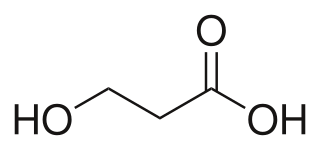Related Research Articles

In chemistry, an alcohol is a type of organic compound that carries at least one hydroxyl functional group bound to a saturated carbon atom. Alcohols range from the simple, like methanol and ethanol, to complex, like sugar alcohols and cholesterol. The presence of an OH group strongly modifies the properties of hydrocarbons, conferring hydrophilic (water-loving) properties. The OH group provides a site at which many reactions can occur.

In organic chemistry, a carboxylic acid is an organic acid that contains a carboxyl group attached to an R-group. The general formula of a carboxylic acid is often written as R−COOH or R−CO2H, sometimes as R−C(O)OH with R referring to an organyl group, or hydrogen, or other groups. Carboxylic acids occur widely. Important examples include the amino acids and fatty acids. Deprotonation of a carboxylic acid gives a carboxylate anion.

In polymer chemistry, condensation polymers are any kind of polymers whose process of polymerization involves a condensation reaction. Natural proteins as well as some common plastics such as nylon and PETE are formed in this way. Condensation polymers are formed by polycondensation, when the polymer is formed by condensation reactions between species of all degrees of polymerization, or by condensative chain polymerization, when the polymer is formed by sequential addition of monomers to an active site in a chain reaction. The main alternative forms of polymerization are chain polymerization and polyaddition, both of which give addition polymers.
In chemistry, a zwitterion, also called an inner salt or dipolar ion, is a molecule that contains an equal number of positively and negatively charged functional groups. With amino acids, for example, in solution a chemical equilibrium will be established between the "parent" molecule and the zwitterion.

In organic chemistry, an aldehyde is an organic compound containing a functional group with the structure R−CH=O. The functional group itself can be referred to as an aldehyde but can also be classified as a formyl group. Aldehydes are a common motif in many chemicals important in technology and biology.
Decarboxylation is a chemical reaction that removes a carboxyl group and releases carbon dioxide (CO2). Usually, decarboxylation refers to a reaction of carboxylic acids, removing a carbon atom from a carbon chain. The reverse process, which is the first chemical step in photosynthesis, is called carboxylation, the addition of CO2 to a compound. Enzymes that catalyze decarboxylations are called decarboxylases or, the more formal term, carboxy-lyases (EC number 4.1.1).
Lactones are cyclic carboxylic esters are intramolecular esters derived from hydroxycarboxylic acids. They can be saturated or unsaturated. Some contain heteroatoms replacing one or more carbon atoms of the ring.
In chemical nomenclature, the IUPAC nomenclature of organic chemistry is a method of naming organic chemical compounds as recommended by the International Union of Pure and Applied Chemistry (IUPAC). It is published in the Nomenclature of Organic Chemistry. Ideally, every possible organic compound should have a name from which an unambiguous structural formula can be created. There is also an IUPAC nomenclature of inorganic chemistry.
Alpha hydroxy carboxylic acids, or α-hydroxy carboxylic acids (AHAs), are a group of carboxylic acids featuring a hydroxy group located one carbon atom away from the acid group. This structural aspect distinguishes them from beta hydroxy acids, where the functional groups are separated by two carbon atoms. Notable AHAs include glycolic acid, lactic acid, mandelic acid, and citric acid.

Anthranilic acid is an aromatic acid with the formula C6H4(NH2)(CO2H) and has a sweetish taste. The molecule consists of a benzene ring, ortho-substituted with a carboxylic acid and an amine. As a result of containing both acidic and basic functional groups, the compound is amphoteric. Anthranilic acid is a white solid when pure, although commercial samples may appear yellow. The anion [C6H4(NH2)(CO2)]−, obtained by the deprotonation of anthranilic acid, is called anthranilate. Anthranilic acid was once thought to be a vitamin and was referred to as vitamin L1 in that context, but it is now known to be non-essential in human nutrition.

β-Hydroxybutyric acid, also known as 3-hydroxybutyric acid or BHB, is an organic compound and a beta hydroxy acid with the chemical formula CH3CH(OH)CH2CO2H; its conjugate base is β-hydroxybutyrate, also known as 3-hydroxybutyrate. β-Hydroxybutyric acid is a chiral compound with two enantiomers: D-β-hydroxybutyric acid and L-β-hydroxybutyric acid. Its oxidized and polymeric derivatives occur widely in nature. In humans, D-β-hydroxybutyric acid is one of two primary endogenous agonists of hydroxycarboxylic acid receptor 2 (HCA2), a Gi/o-coupled G protein-coupled receptor (GPCR).

Hydroxybutyric acid is a group of four-carbon organic compounds that have both hydroxyl and carboxylic acid functional groups. They can be viewed as derivatives of butyric acid. The carboxylate anion and the esters of hydroxybutyric acids are known as hydroxybutyrates. β-hydroxybutyric acid is relevant to human health as it is a member of a class of products of fatty acid oxidation referred to as ketone bodies.

A beta hydroxy carboxylic acid or β-hydroxy carboxylic acid (BHA) is a carboxylic acid containing a hydroxy functional group separated by two carbon atoms. They are related to alpha hydroxy acids, in which the two functional groups are separated by only one carbon atom.

In organic chemistry, alkanolamines are organic compounds that contain both hydroxyl and amino functional groups on an alkane backbone. Most alkanolamines are colorless.

In organic chemistry, keto acids or ketoacids are organic compounds that contain a carboxylic acid group and a ketone group. In several cases, the keto group is hydrated. The alpha-keto acids are especially important in biology as they are involved in the Krebs citric acid cycle and in glycolysis.

3-Hydroxy-2-naphthoic acid is an organic compound with the formula C10H6(OH)(CO2H). It is one of the several hydroxynaphthoic acids. It is a precursor to some azo dyes and pigments. It is prepared by carboxylation of 2-naphthol by the Kolbe–Schmitt reaction.

N-Phenylglycine is an organic compound with the formula C6H5NHCH2CO2H. This white solid achieved fame as the industrial precursor to indigo dye. It is a non-proteinogenic alpha amino acid related to sarcosine, but with an N-phenyl group in place of N-methyl.

Allothreonine is an amino acid with the formula CH3CH(OH)CH(NH2)CO2H. It is the diastereomer of the amino acid threonine. Like most other amino acids, allothreonine is a water-soluble colorless solid. Although not one of the proteinogenic amino acids, it has often been the subject for the synthesis of novel proteins using an expanded genetic code. Racemic allothreonine can be produced in the laboratory from bromomethoxybutyric acid.
2-Hydroxy-4-(methylthio)butyric acid is an organic compound with the structural formula CH3SCH2CH2CH(OH)CO2H. It is a white solid. In terms of functional groups, the molecule is a α-hydroxy carboxylic acid and a thioether. The compound is structurally related to the amino acid methionine by replacement of the amine with a hydroxy group.

2-Hydroxyisobutyric acid is the organic compound with the formula (CH3)2C(OH)CO2H. A white solid, it is classified as an hydroxycarboxylic acid. It has been considered as a naturally occurring precursor to polyesters. It is closely related to lactic acid.
References
- ↑ Miltenberger, Karlheinz (2000). "Hydroxycarboxylic Acids, Aliphatic". Ullmann's Encyclopedia of Industrial Chemistry . Weinheim: Wiley-VCH. doi:10.1002/14356007.a13_507. ISBN 978-3527306732.